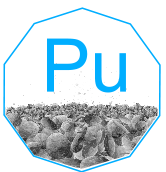Plutonium

Plutonium (Pu)
General Information
- Symbol: Pu
- Atomic Number: 94
- Atomic Weight: 244 u (variable as it has many isotopes)
- Element Category: Actinide
- Group: N/A (Actinides series)
- Period: 7
- Block: f-block
Physical Properties
- Appearance: Silvery-gray metallic, tarnishes to a dull gray when exposed to air
- Density: 19.816 g/cm³
- Melting Point: 639.4 °C (1182.9 °F)
- Boiling Point: 3228 °C (5842 °F)
- Phase at STP: Solid
- Electron Configuration: [Rn] 5f⁶ 7s²
- Oxidation States: +3, +4, +5, +6 (most common)
Chemical Properties
- Reactivity: Plutonium is highly reactive, forming various oxides and hydrides. It reacts with oxygen, water, and acids.
- Compounds: Forms compounds such as plutonium dioxide (PuO₂), plutonium(IV) fluoride (PuF₄), and plutonium(III) chloride (PuCl₃).
Uses and Applications
- Nuclear Weapons: Plutonium-239 is a critical component in nuclear weapons due to its ability to sustain a chain reaction.
- Nuclear Fuel: Used as a fuel in nuclear reactors and in mixed oxide (MOX) fuel.
- Radioisotope Thermoelectric Generators (RTGs): Plutonium-238 is used to generate power for space missions and other remote applications.
Occurrence and Extraction
- Natural Occurrence: Plutonium is not found in significant quantities in nature; it is primarily man-made.
- Production: Produced in nuclear reactors by neutron capture of uranium-238 followed by beta decay.
Isotopes
- Stable Isotopes: Plutonium has no stable isotopes.
- Radioactive Isotopes: The most significant isotopes are Plutonium-239 (half-life of 24,100 years), Plutonium-240 (half-life of 6,560 years), and Plutonium-238 (half-life of 87.7 years).
Safety and Handling
- Hazards: Plutonium is highly toxic and radioactive. It poses significant health risks if inhaled or ingested and can cause radiation poisoning and cancer.
- Precautions: Handle with extreme care, using appropriate protective equipment and working in controlled environments. Proper disposal of radioactive materials is crucial.
History
- Discovery: Discovered by Glenn T. Seaborg, Arthur Wahl, and Joseph W. Kennedy in 1940.
- Name Origin: Named after the dwarf planet Pluto.
Additional Facts
- Crystal Structure: Varies with temperature, but most common structures are monoclinic and face-centered cubic (fcc).
- Magnetic Properties: Paramagnetic
- Thermal Conductivity: 6.74 W/m·K
- Electrical Resistivity: 146 µΩ·cm at 25°C
Summary
Plutonium is a highly significant and dangerous element used primarily in nuclear weapons and as a nuclear fuel. It is produced synthetically in reactors and has critical applications in energy generation and space missions. Discovered in 1940, plutonium requires meticulous handling due to its high radioactivity and toxicity.
40 Question and Answer Pairs About Plutonium
What is the atomic number of Plutonium?
- 94
What is the symbol for Plutonium?
- Pu
What is the atomic weight of Plutonium?
- 244 u (variable as it has many isotopes)
In which group of the periodic table is Plutonium found?
- Actinides series (no specific group)
What period is Plutonium in?
- Period 7
What block does Plutonium belong to?
- f-block
What is the density of Plutonium?
- 19.816 g/cm³
What is the melting point of Plutonium?
- 639.4 °C (1182.9 °F)
What is the boiling point of Plutonium?
- 3228 °C (5842 °F)
What is the electron configuration of Plutonium?
- [Rn] 5f⁶ 7s²
What are the common oxidation states of Plutonium?
- +3, +4, +5, +6 (most common)
What is the appearance of Plutonium?
- Silvery-gray metallic
Is Plutonium reactive with air?
- Yes, it tarnishes to a dull gray when exposed to air.
Name a compound of Plutonium.
- Plutonium dioxide (PuO₂)
What is a common use of Plutonium-239?
- Used in nuclear weapons and as a fuel in nuclear reactors.
How is Plutonium used in space missions?
- Plutonium-238 is used in RTGs to generate power.
What role does Plutonium play in nuclear reactors?
- Used as a fuel and in MOX fuel.
How is Plutonium typically produced?
- By neutron capture of uranium-238 followed by beta decay.
What is the most significant isotope of Plutonium for nuclear weapons?
- Plutonium-239
How is Plutonium extracted?
- Produced synthetically in nuclear reactors.
What safety hazard is associated with Plutonium dust?
- It is highly toxic and radioactive, posing significant health risks.
Who discovered Plutonium?
- Glenn T. Seaborg, Arthur Wahl, and Joseph W. Kennedy
Where does the name Plutonium come from?
- Named after the dwarf planet Pluto.
What is the crystal structure of Plutonium at room temperature?
- Monoclinic
Is Plutonium paramagnetic or diamagnetic at room temperature?
- Paramagnetic
What is the thermal conductivity of Plutonium?
- 6.74 W/m·K
What is the electrical resistivity of Plutonium at 25°C?
- 146 µΩ·cm
What is the primary oxidation state of Plutonium in its compounds?
- +4
Is Plutonium found as a free element in nature?
- No, it is primarily man-made.
What is the common name of Plutonium(IV) fluoride?
- PuF₄
What is a major application of Plutonium in the energy industry?
- Nuclear fuel for reactors and RTGs.
How does Plutonium benefit space missions?
- Provides power through RTGs.
What is the melting point of Plutonium in Kelvin?
- 912.4 K
What group does Plutonium belong to in the periodic table?
- Actinides series
What is the natural abundance of Plutonium-239?
- It is produced synthetically and is not found naturally in significant amounts.
Can Plutonium be used in high-temperature applications?
- Yes, particularly in nuclear reactors.
What is the key property that makes Plutonium valuable in nuclear fuel?
- Its ability to sustain a chain reaction.
How is Plutonium used in the chemical industry?
- Mainly in research and specialized applications.
What precautions should be taken when handling Plutonium?
- Use appropriate protective equipment to avoid inhalation or ingestion.
What are the health risks associated with Plutonium?
- It can cause radiation poisoning and cancer if inhaled or ingested.






